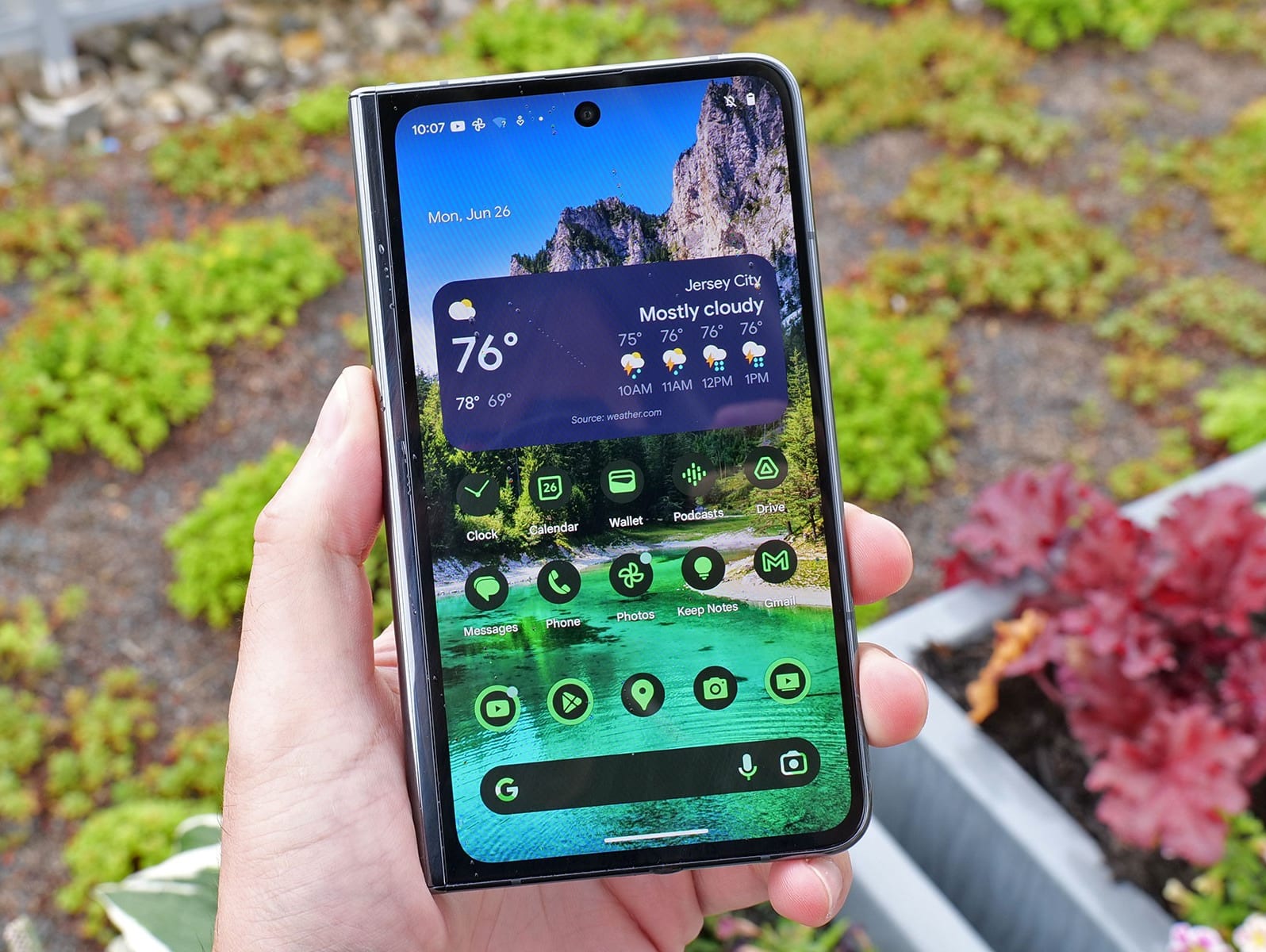Google Pixel Fold review: The challenger that Samsung needs
For the past few years, Samsung’s Galaxy Z Fold line has been the undisputed champion of big flexible phones. But it holds that title almost by default thanks to a lack of real contenders — especially outside of China. But with the Pixel Fold, Google has created a legitimate challenger with an innovative design that directly addresses some of Samsung’s weaknesses in the space. So even though its $1,799 price will be a nonstarter for most, Google’s first flagship foldable phone is still a notable rival.
Design and displays
The Google Pixel Fold features a 5.8-inch exterior screen that opens up to reveal a flexible 7.6-inch interior display, both of which are 120Hz OLED panels. On paper, that sounds very similar to what Samsung offers on the Z Fold 4, but Google has played around with the phone’s build and dimensions to create what might be the best showcase of the company’s design chops to date.
Google Pixel Fold

Pros
- Big exterior display
- Great cameras
- Solid battery life
- Sleek design
- Straightforward multitasking
Cons
- Expensive
- Heavy
Instead of something like Samsung’s skinnier baton-like form, Google chose a wider 17.4:9 aspect ratio for the Pixel Fold’s 2,092 x 1,080 exterior display, resulting in a device shaped more like a passport. The benefit is you don’t need to switch to the bigger interior screen as often. And while this might seem like a minor tweak, it makes a huge difference.
The Z Fold 4’s cover display is so skinny that typing feels cramped. It’s really only usable for basic things like looking up directions or checking notifications. But on the Pixel Fold, everything just kind of works. The screen is small enough that someone with medium-sized hands like me doesn’t have trouble reaching the corners of the screen, yet big enough that apps look and behave normally. And because you don’t need to open the device as often, the battery can actually last a little longer.

Subscribe to the Engadget Deals Newsletter
Great deals on consumer electronics delivered straight to your inbox, curated by Engadget’s editorial team. See latest

Please enter a valid email address
Please select a newsletter
By subscribing, you are agreeing to Engadget’s Terms and Privacy Policy.
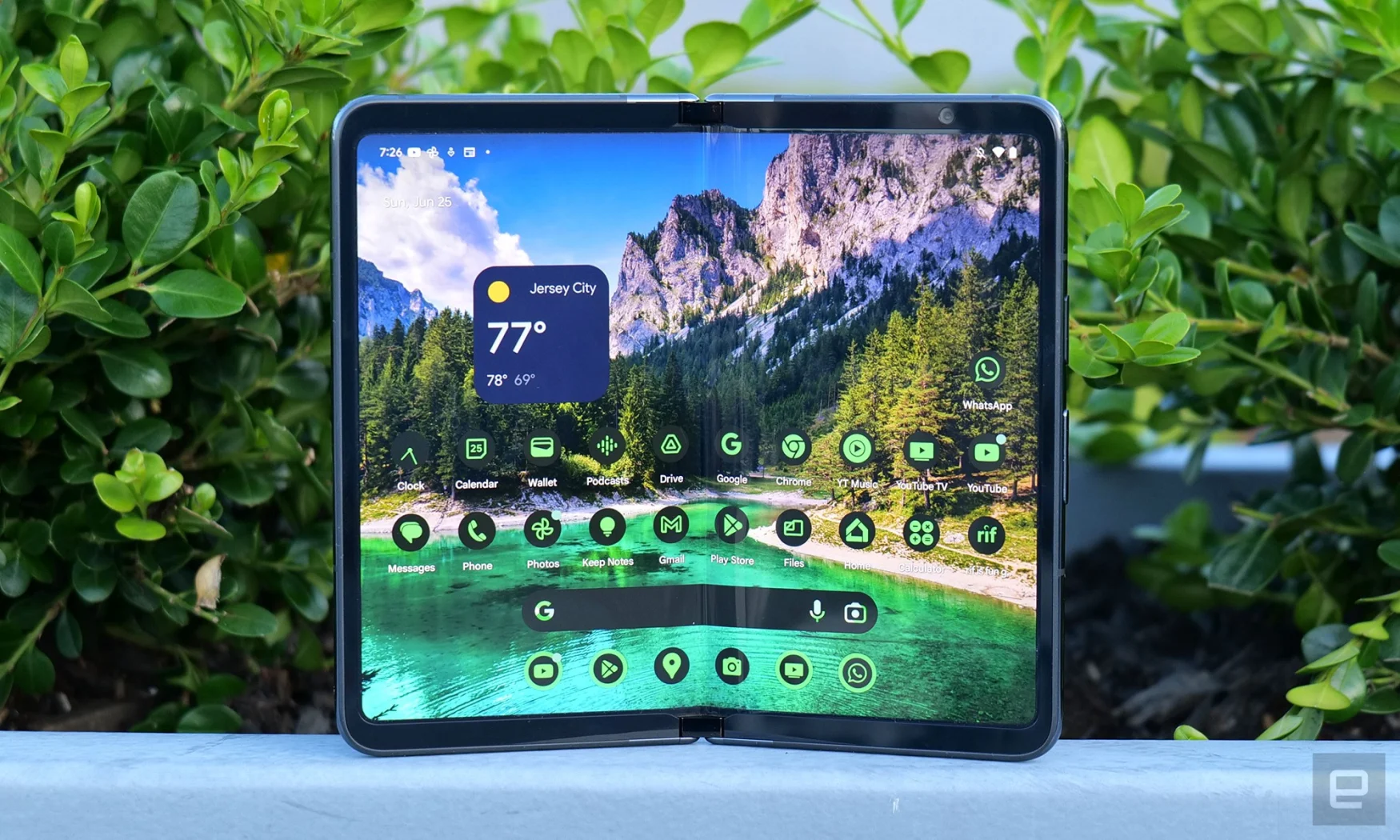
Perhaps more importantly, Google has done some nifty things with the Pixel Fold’s hinge and chassis so there’s essentially no gap between the phone’s halves while still being extremely thin. It measures less than 6mm thick and around 12.1mm when closed, so despite being a touch heavier than the Z Fold 4, it feels more balanced. Unless your jeans are painted on, you shouldn’t have much trouble fitting the Pixel Fold in a pocket. And unlike so many other flexible phones, the Pixel Fold has an IPX8 rating for water resistance, so you don’t need to fear an accidental splash or submersion.
One side effect of having a wider screen on the outside is that when you open the Pixel Fold, you get a landscape orientation that’s great for watching videos. After starting a clip on the outside screen, you can just unfold the phone, expand it and voila, no need to rotate. Instead of going for a completely bezel-less design like most traditional phones, Google gave the Pixel Fold slightly larger love handles. This means there’s no need for a low-res under-display selfie camera like on the Z Fold 4. There’s actually room for an 8-megapixel camera in the top right corner. And that extra space around the hinge lets you hold the Pixel Fold like a paperback book, which is especially satisfying when you’re using it as an e-reader.
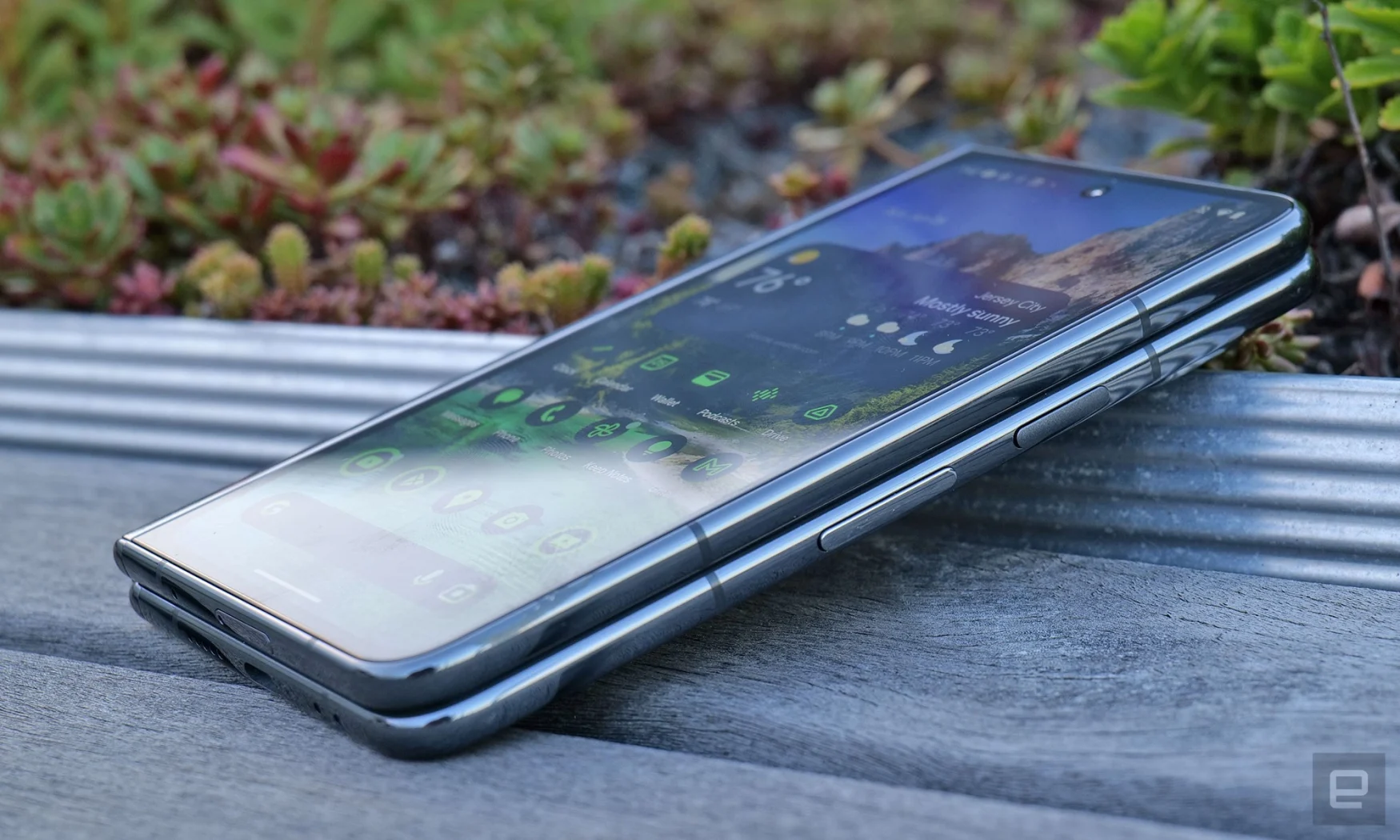
It’s about time I addressed the elephant in the room: Yes, there’s a crease. You can feel it with your fingers and, depending on the angle, you can see it too. But Google has managed to minimize how distracting it is. That said, I’ve been using a foldable phone as my daily driver for the last three years, so I may be more used to it than most.
Durability
While foldables have been around for a few years, now that Google is getting into the game, there are some things that potential first-time flexible phone buyers should be aware of. When you first open the Pixel Fold’s box, there’s a warning that calls attention to the phone’s display. Google notes that “flexible screens are softer than traditional phone screens, so avoid contact with sand, crumbs, fingernails or sharp objects.” Additionally, Google says that the owners should not “remove the pre-installed screen protector,” and that users should “avoid installing third-party screen protectors.” In short, you have to be a little more gentle with foldable phones than your standard glass-and-metal handset.
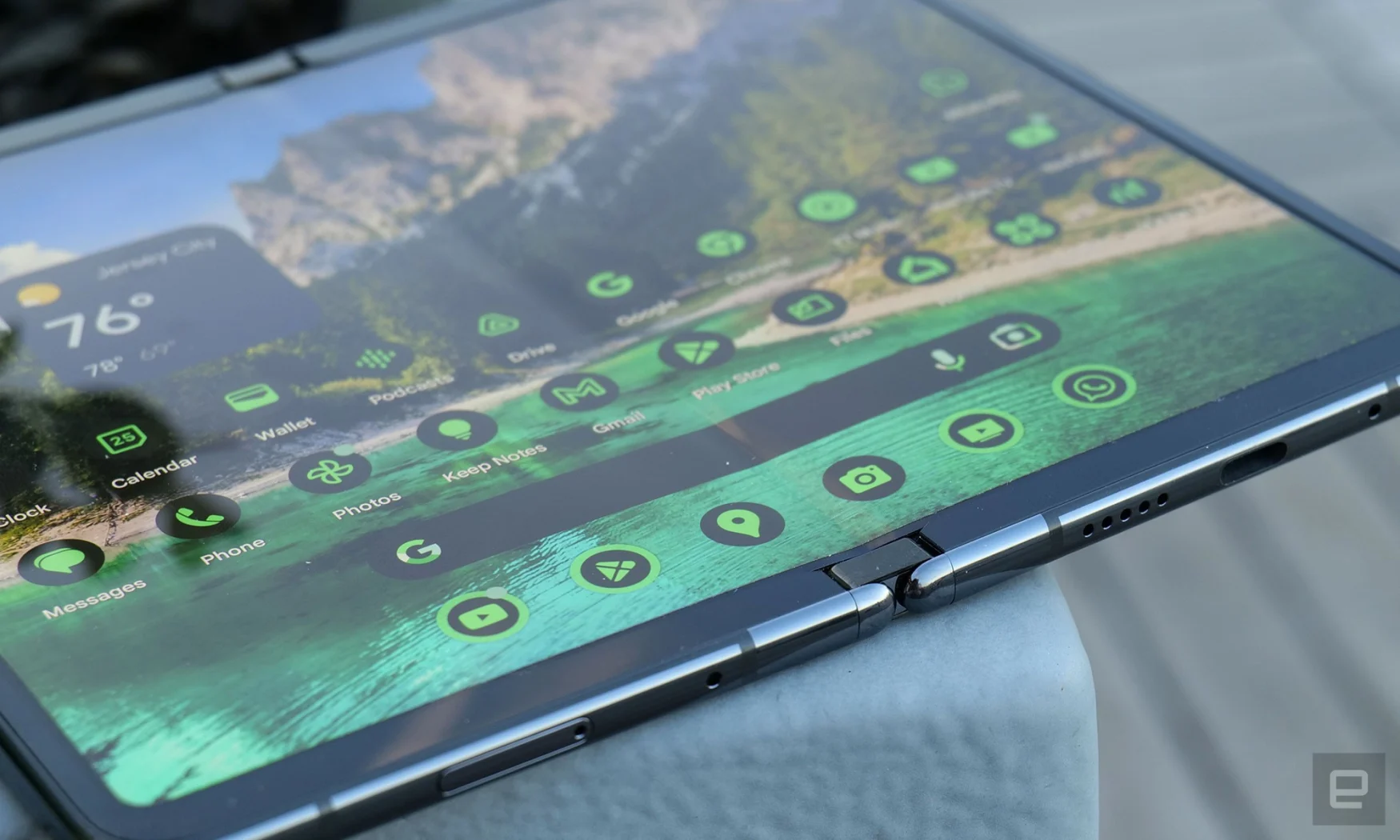
So far, I haven’t had any issues with the Pixel Fold’s display or its pre-installed screen protector. That said, I’ve owned three Galaxy Z Fold phones with similar screen protectors that bubbled up six to eight months after purchase, so it’s possible the Pixel Fold may exhibit similar issues over time. When questioned further about durability and customer support, a Google spokesperson told Engadget: “We have rigorously tested the screen protector to stand up to normal wear and tear. If you do encounter an issue, it can be repaired at our service centers for a fee ($29 for preferred care customers or $129 for customers out of warranty).”
Software and apps
We can’t talk about the phone’s interior display without mentioning some of the tweaks Google has made to the apps and UI. Similar to the Z Fold 4, Google created a taskbar for the Pixel Fold, except that this one is a bit more transient. On the home screen, you get your standard row of icons along the bottom. But when you’re in an app, you can swipe up to see the taskbar, and from there you can drag an icon to open it in multi-window mode.
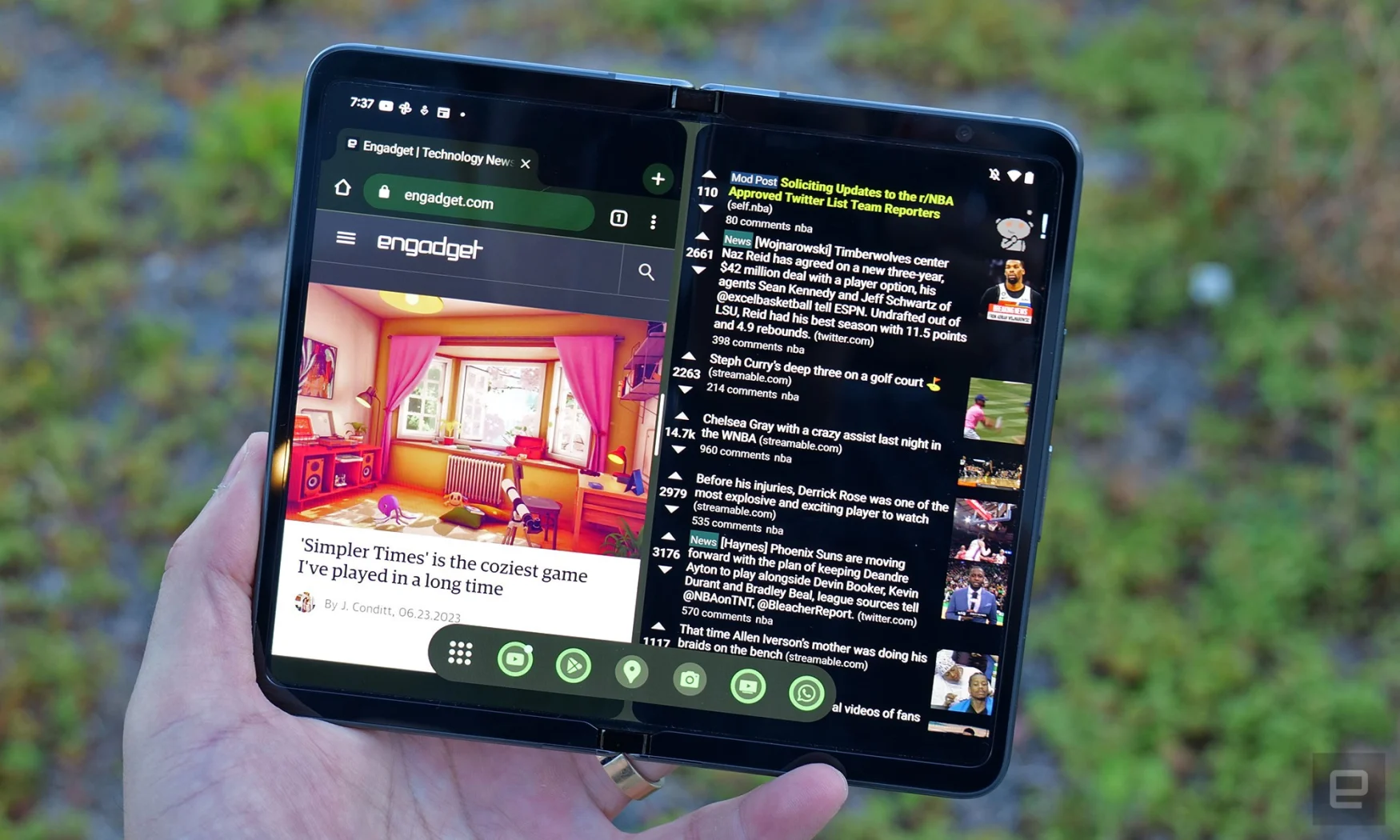
The gesture for summoning the taskbar is like a shorter version of swiping up and holding to see recently used apps. Once you select the apps you want, resizing windows is as easy as dragging the divider left or right. If you’d like your apps to switch sides you can double-tap the middle of the split-screen divider. The idea is for the taskbar to appear when you need it and get out of your way when you don’t. When combined with the App Suggestion feature in Android (which are the apps that have a ring around the icon), it makes for a simple but effective way of multitasking.
You can also use the Pixel Fold’s dual displays to do stuff like take selfies using the phone’s high-res rear cameras or show your subjects a live preview of what they look like when you’re taking their photo. But we’ve seen that before on devices like the Z Fold and the new Razr+. Unfortunately, one of the Pixel Fold’s coolest new features — Dual-Screen Interpreter mode — isn’t available yet, as it’s based on features in Android 14, which won’t be out until sometime in the fall.
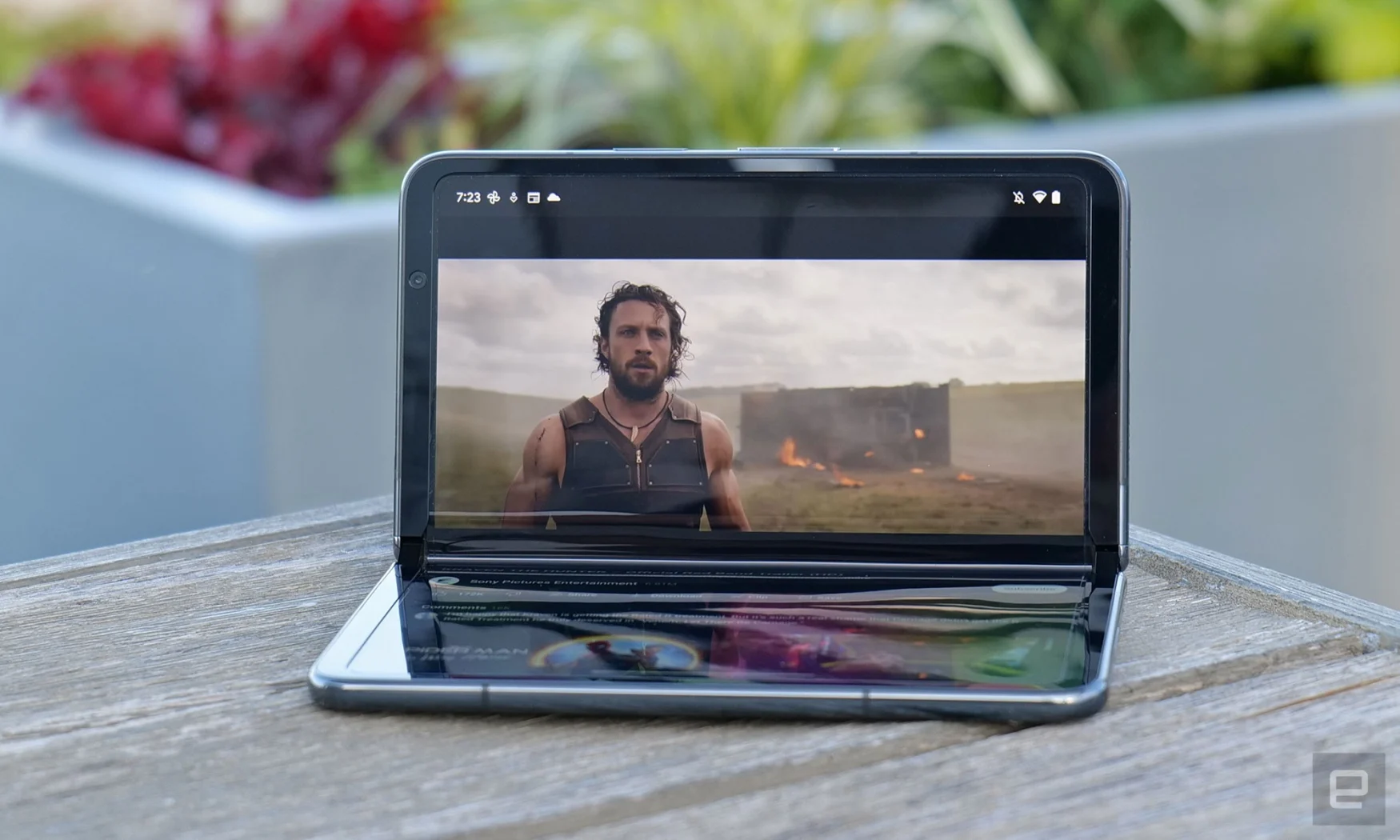
Google says that over 50 first-party apps have already been optimized for use on devices like the Pixel Fold. Some of the enhancements we’ve gotten a taste of before, like tabletop mode in YouTube. But there are a number of refined examples, including those from third parties like WhatsApp where you can share images from Google Photos just by dragging and dropping. With this much real estate to work with, you really do feel empowered when switching from the outside to the interior display. And after playing games like Asphalt 9 that support adaptive resolutions, I’m really hoping more developers get on board.
Cameras
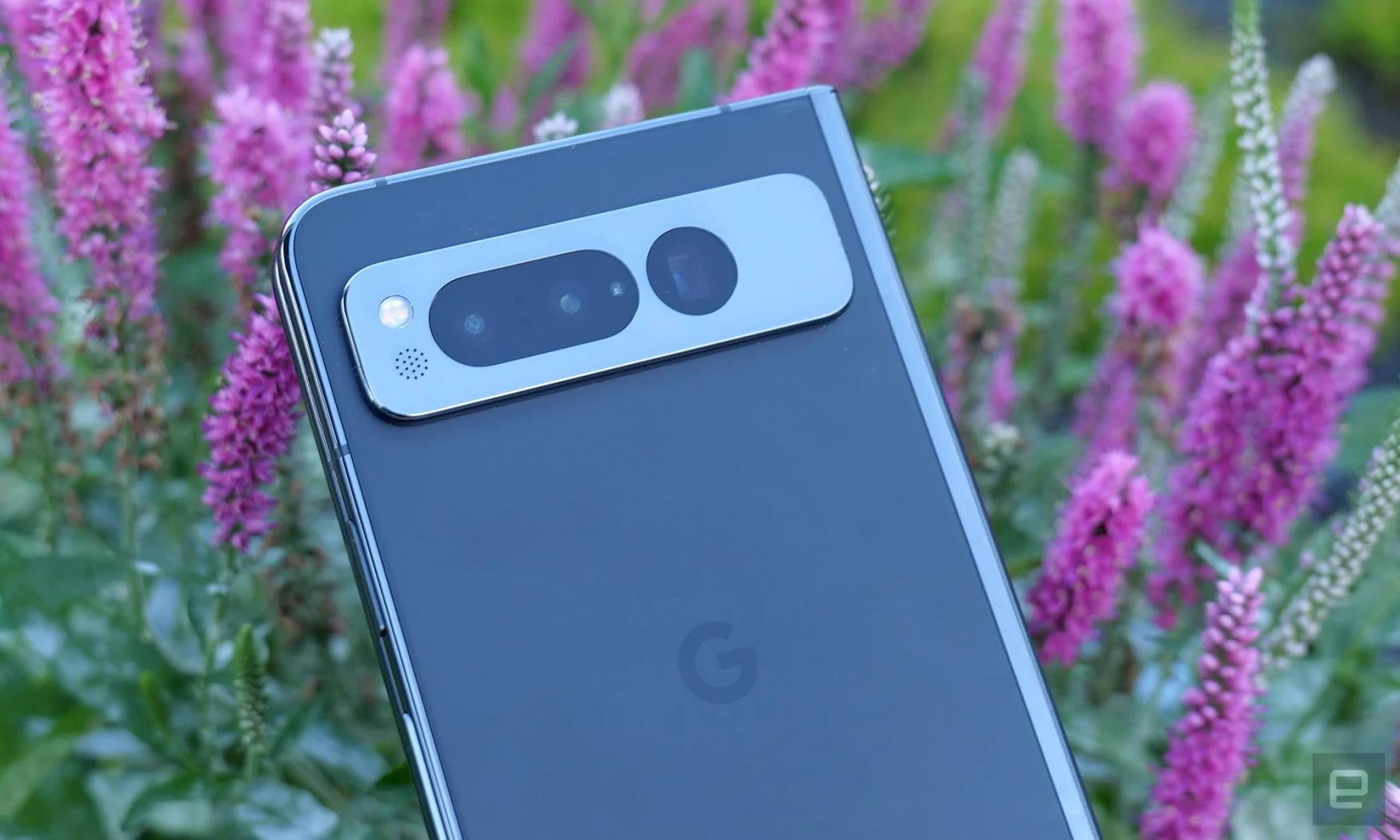
One of my biggest gripes with the Z Fold 4 is that Samsung wasn’t able to deliver the same level of image quality that you get on the Galaxy S Ultra. But the Pixel Fold doesn’t feel as compromised. It features a 48MP main sensor, a 10.8MP ultrawide and a 10.8MP telephoto with a 5x optical zoom. Combine that with Google’s excellent photo processing and the result is cameras that are just flat-out better.
Gallery: Pixel Fold camera samples | 10 Photos
Gallery: Pixel Fold camera samples | 10 Photos
In daylight, the Pixel Fold’s pics were consistently a touch sharper than Samsung’s while often delivering more detail with better shadows and highlights. Even with Samsung’s food mode activated, the Pixel Fold made my taco dinner look more appetizing too. Google’s Night Sight continues to reign supreme when it comes to capturing clearer and more well-exposed photos in the dark.
Performance and battery life
Powering the Pixel Fold is Google’s Tensor G2 along with 12GB of RAM and up to 512GB of storage. It’s not an overflowing well of speed, and as people have experienced on other Pixel devices, the Fold sometimes runs a little warm. But even when I was multitasking or trying to push it, the phone never felt lethargic, which is all I can really ask for.
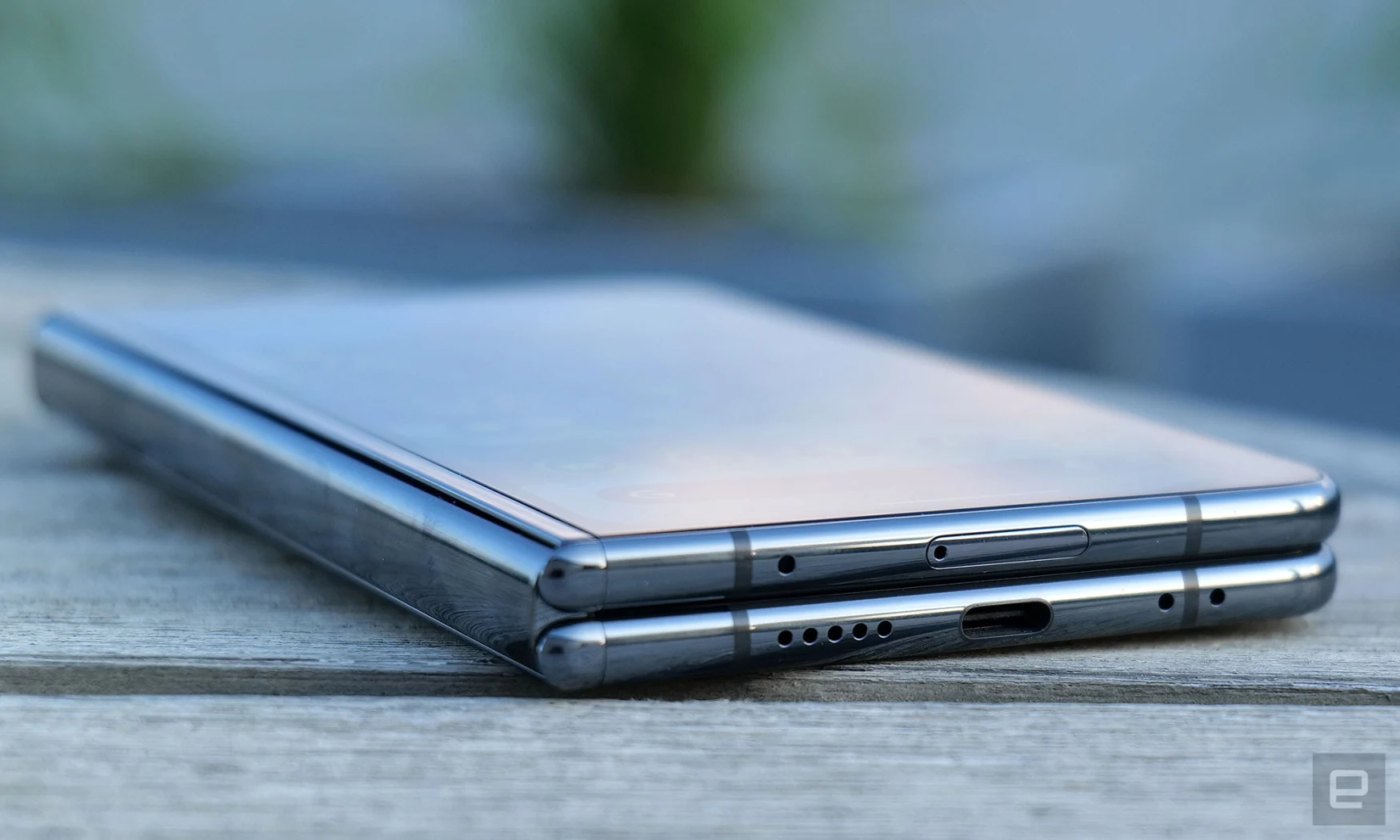
Meanwhile, even though Google’s 4,820mAh battery is a tiny bit smaller than on the Z Fold 4, there wasn’t a big difference in overall longevity, which is to say it’s pretty good. I ran our video rundown test on both their external and internal displays. On the former, the Pixel Fold outlasted Samsung’s big foldable, posting a time of 22 hours and 21 minutes versus the latter’s 20:45. Using their larger screens, though, the Z Fold 4 came out ahead with a time of 17:13 compared to the Pixel’s 15:42.
Wrap-up
For Google’s entry into the world of flexible phones, the Pixel Fold feels like a win. Its clever hinge and slim chassis make it easy to use and carry, while its wider body delivers on Google’s promise of making the phone’s exterior screen a lot more usable. Featuring strong water resistance, better cameras and UI tweaks to make multitasking a tiny bit simpler, the Pixel Fold more than holds its own against Samsung’s Z Fold 4. And that’s before considering all the great Pixel-specific features like Call Screener, Recorder and more.
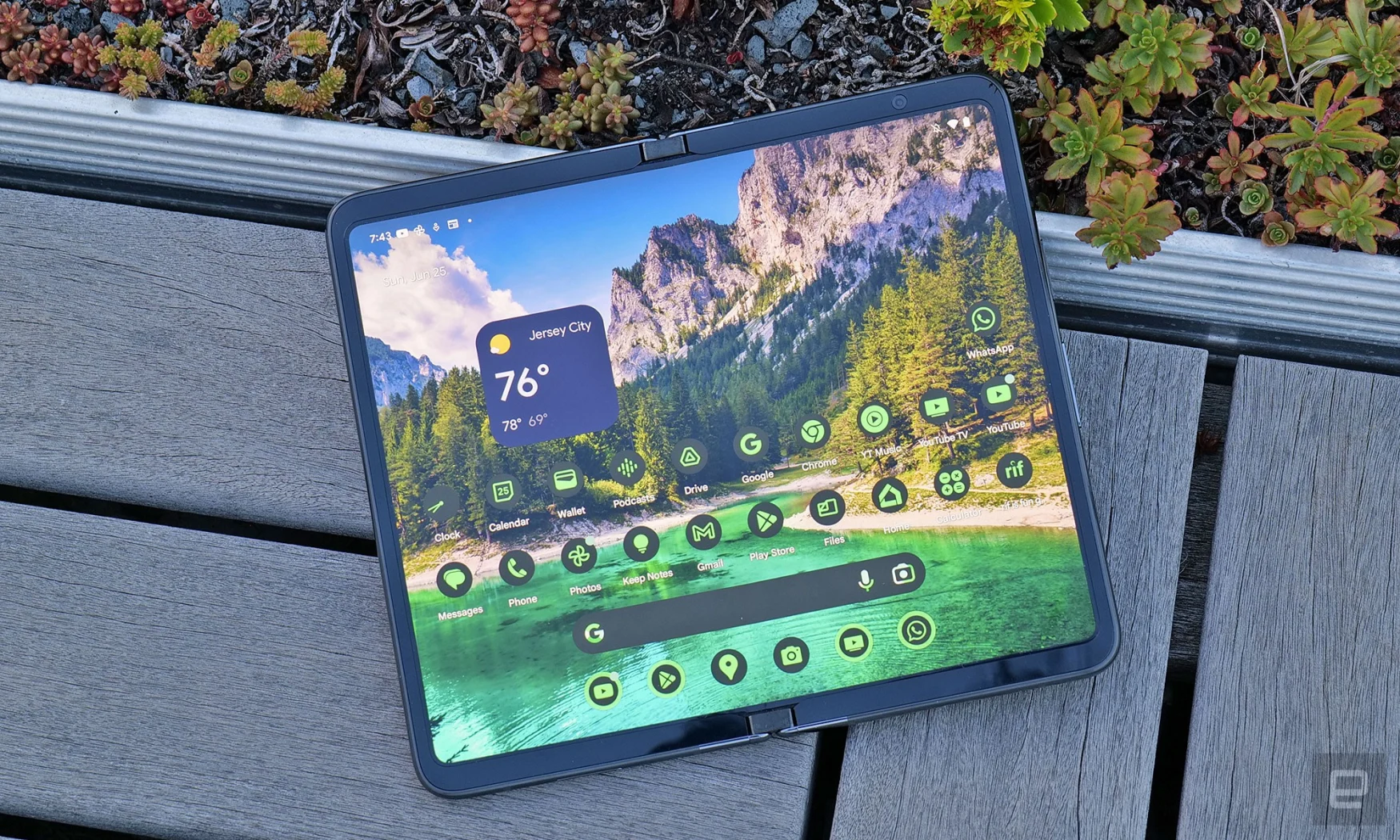
My main gripes (you know, aside from its price) are that it occasionally feels like the phone is never fully open. Sometimes I feel like I have to put more pressure on it than I’d like to make it completely flat. And while it would be nice if the Pixel Fold came with stylus support like the Z Fold 4, I’m happy to wait till Samsung, Google or whoever finds room to store a pen inside the device.
Admittedly, some people may say that the Pixel Fold isn’t really advancing the overall capabilities of flexible phones, as many of its features like dual-window multitasking are already available on devices like the Z Fold 4. The issue is that until we get a critical mass of big foldables, developers aren’t going to consider tweaking or optimizing their apps. That’s why this phone had to come first. With the Pixel Fold, Google brought its style and rhythm to a title fight and didn’t come up short. But, perhaps most importantly, Google now has a device it can use to shape the future of Android beyond typical glass bricks.

